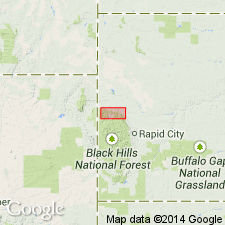
- Usage in publication:
-
- SCOLITHUS quartzite*
- Modifications:
-
- [Principal reference]
- AAPG geologic province:
-
- Williston basin
Summary:
Pg. 16, 18 (fig. 1), 20-21 (table); T.A. Jaggar, Jr., 1901, USGS Ann. Rpt. 21, pt. 3, Black Hills laccoliths, p. 176, 178 (fig. 60), 180-181 (table).
SCOLITHUS [SKOLITHOS] quartzite in Deadwood formation. The Cambrian section (Deadwood formation) of northern Black Hills, South Dakota, is divided into (descending): (1) shales, 20 to 40 feet; (2) SCOLITHUS quartzite, 5 to 12 feet; (3) shales, flaggy limestones, and sandstones, 200 to 400 feet; (4) shale and limestone, 30 feet [Jaggar previously (1901, fig. 60) mis(?)-labelled this sandstone]; and (5) conglomerate, 0 to 30 feet. In places, the hard and salient "worm-eaten" (Scolithus) quartzite forms a bench jutting out from beneath the thick, soft, green shales. Included the Deadwood formation in his ore-bearing series. Lies between Ordovician and Algonkian age rocks.
[Typical exposure] of Cambrian (Deadwood) section stated to be on west side of Whitewood Creek, just below Deadwood.
Source: Publication.
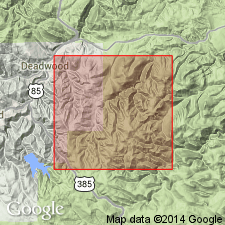
- Usage in publication:
-
- "SCOLITHUS sandstone"
- Modifications:
-
- Areal extent
- AAPG geologic province:
-
- Williston basin
Summary:
Pg. 1329-1341. "SCOLITHUS [SKOLITHOS] sandstone". Reported finding of poorly preserved Ordovician (Middle?) fossils [listed and figured] in upper 70 feet of Deadwood formation of type section, and they recommended transfer of these beds from Deadwood formation to overlying Whitewood limestone (which is classified by the USGS as Upper Ordovician). These 70 feet of beds are described as consisting of (descending): (1) transitional, 10 feet; (2) siltstone member, 20 feet, numerous fossils; and (3) shale member, 40 feet, few fossils. They rest on a sandstone, called "SCOLITHUS sandstone," 15 feet thick, which has not yielded fossils. Authors conclude with following statements: data presented seem to indicate that all beds in northern Black Hills above SCOLITHUS sandstone and below typical Whitewood dolomite may be correlated with Middle Ordovician. No diagnostic fossils were found in SCOLITHUS sandstone or subjacent beds, and their age was not determined. Typical Whitewood dolomite presumably is Upper Ordovician. It seems advisable for the present at least to include all Ordovician beds above SCOLITHUS sandstone in Whitewood formation.
Source: US geologic names lexicons (USGS Bull. 896, Deadwood entry p. 577-578).
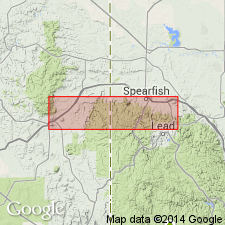
- Usage in publication:
-
- SKOLITHOS (SCOLITHUS) sandstone
- Modifications:
-
- Not used
- AAPG geologic province:
-
- Williston basin
Summary:
Pg. 46. SKOLITHOS sandstone (sometimes but not preferably spelled "SCOLITHUS") of earlier geologists [notably Furnish and others, 1936] is named Aladdin sandstone. [See entry under Aladdin.]
Source: Publication.
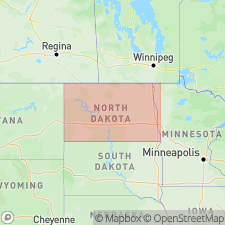
- Usage in publication:
-
- SKOLITHOS (SCOLITHUS) sandstone
- Modifications:
-
- Areal extent
- AAPG geologic province:
-
- Williston basin
Summary:
Pg. 8-11; C.G. Carlson, 1958 (1959), Stratigraphy of Deadwood-Winnipeg interval in North Dakota and northwestern South Dakota, 2nd Intl. Williston Basin Symp., p. 20-26. SKOLITHOS sandstone in Deadwood formation ("SCOLITHUS quartzite" of Furnish and others, 1936). Fine- to medium-grained, moderately well-sorted, quartzitic, SKOLITHOS-bearing sandstone at top of Deadwood formation. Thickness 12 to 25 feet. (=Aladdin sandstone of McCoy, 1952, and unit B of Whitewood formation of Butler and others, 1955.) Lies beneath Icebox member of Winnipeg formation and above unnamed middle part of Deadwood formation (=unit A of Whitewood formation of Butler and others, 1955) consisting of limestone, limestone conglomerate, shale and sandstone. Age is considered Early Ordovician, [based on stratigraphic relations].
In footnote (p. 8), author retains original spelling of SKOLITHOS, as pointed out by [B.F.] Howell, 1940 [reference excluded from bibliography], and Rules of Zoological Nomenclature, art. 19.
Source: Publication.
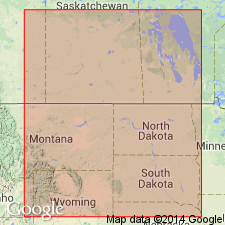
- Usage in publication:
-
- SCOLITHUS sandstone
- Modifications:
-
- Overview
- AAPG geologic province:
-
- Powder River basin
- Williston basin
Summary:
Sedimentary considerations weigh heavily in favor of leaving SCOLITHUS [SKOLITHOS] sandstone in Deadwood. Reasons are reviewed. Is Ordovician in age.
Source: GNU records (USGS DDS-6; Denver GNULEX).
For more information, please contact Nancy Stamm, Geologic Names Committee Secretary.
Asterisk (*) indicates published by U.S. Geological Survey authors.
"No current usage" (†) implies that a name has been abandoned or has fallen into disuse. Former usage and, if known, replacement name given in parentheses ( ).
Slash (/) indicates name conflicts with nomenclatural guidelines (CSN, 1933; ACSN, 1961, 1970; NACSN, 1983, 2005, 2021). May be explained within brackets ([ ]).

